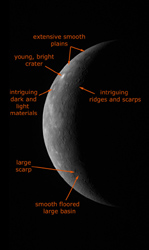
Click on image for larger annotated versionEarlier today, at 4:40 am EDT, MESSENGER passed a mere 200 kilometers (124 miles) above Mercury’s surface for its closest approach to the planet during the mission’s second Mercury flyby. Now, the spacecraft is speeding away from Mercury, acquiring science observations as it goes. The planned flyby science observations continue for about 20 hours following closest approach, and only after the completion of all science observations will the data be transmitted to Earth. For the moment, the MESSENGER team waits.
However, scientists on the team are already eagerly exploring the optical navigation images acquired just prior to the flyby. Shown here is a NAC image from the eighth and final optical navigation image set, taken about 14.5 hours before the flyby’s closest approach; Mercury appears as a thin sunlit crescent. Though much of Mercury is in darkness in this image, the visible portion had never been seen by spacecraft before. This portion of Mercury’s surface was not viewed during any of Mariner 10’s three flybys or during MESSENGER’s first flyby earlier this year. The newly imaged terrain shows a wide range of geologic features. Near the northern limb of the planet, extensive smooth plains, possibly volcanic in origin, are identified. A nearby crater is the brightest feature visible in the image, suggesting a relatively young age. This bright crater is consistent with a bright feature seen in Earth-based telescopic observations. In the southern region, a large basin is seen with a smooth floor, likely also a product of volcanism. A large scarp that appears to cut through this basin may have formed as Mercury cooled and contracted.
Many more features in this image have also captured the MESSENGER team’s interest. Hints of ridges and scarps are barely discernible near the terminator, and a crater near the limb suggests the presence of intriguing dark and light materials. With the comparatively low resolution of this image, any insight that can be gained into these areas is limited. But that limitation will not last long. After all, this is just an optical navigation image. Early this morning, MESSENGER acquired a NAC mosaic of this same area with a resolution ten times higher! As the first images from the flyby begin to arrive early Tuesday morning, the MESSENGER team will see these features in great detail as well as other large expanses of Mercury not yet viewed by spacecraft.
Date Acquired: October 5, 2008
Image Mission Elapsed Time (MET): 131717310
Instrument: Narrow Angle Camera (NAC) of the Mercury Dual Imaging System (MDIS)
Resolution: 7 kilometers/pixel (4 miles/pixel)
Scale: Mercury’s diameter is 4880 kilometers (3030 miles)
Spacecraft Altitude: 270,000 kilometers (170,000 miles)
Sub-spacecraft Latitude and Longitude: 1.6°N, 129.8°E
These images are from MESSENGER, a NASA Discovery mission to conduct the first orbital study of the innermost planet, Mercury. For information regarding the use of images, see the MESSENGER image use policy.

